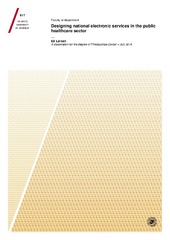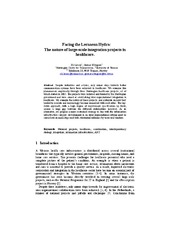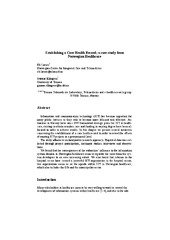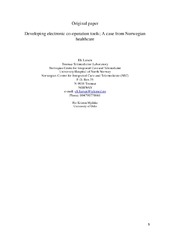| dc.contributor.advisor | Ellingsen, Gunnar | |
| dc.contributor.author | Larsen, Eli | |
| dc.date.accessioned | 2015-01-05T10:13:59Z | |
| dc.date.available | 2015-01-05T10:13:59Z | |
| dc.date.issued | 2014-12-12 | |
| dc.description.abstract | This thesis deals with a socio-technical approach towards the development of inter-organisational ICT tools in healthcare. My overall case is Norwegian healthcare, and I investigated how national inter-organisational ICT tools were developed and why good results were difficult to achieve. Three public projects make up the basis of my data collection in which the main categories of data are interviews, participant observations and document studies. The data collection period spanned 2005 to the completion of this thesis.
The main contribution of this thesis is the empirical insight into the long-standing establishment of inter-organisational health care services in Norway, a country that is characterised primarily by a publicly funded healthcare system. Studying this domain have demanded an inter-disciplinary approach because of the need to understand work practices, the implications of development and the complexities of information infrastructures, financing, project management, political governance and political philosophies.
This study demonstrates how the strategies adopted by Norwegian authorities have changed. These strategies began as measures for invigorating the sector through the funding of public projects that establish specifications which vendors can use in developing new services. The strategies have transitioned into a top-down approach, with the Directorate of Health as the dominant stakeholder in a dedicated and specialised market. The recent strategy represents an approach that prioritises projects in a political process instead of basing such projects in extensive discussions in the healthcare sector.
On the basis of the results, I suggest that a middle position be adopted in organising large-scale projects on integrated information systems. Such a strategy will give more power to the users of the information system. I believe that in real-world settings, a step-by-step strategy is favourable but requires good conditions for continued growth. Critical tasks are to break down large projects into a series of smaller ones, prioritise direct business value and assemble stable, full-time and cross-functional teams that execute these projects along a disciplined agile and optimisation approach. | en |
| dc.description.doctoraltype | ph.d. | en |
| dc.description.popularabstract | Hvorfor er det så vanskelig å oppnå gode elektroniske samhandlingsverktøy for norsk helsevesen? Denne problemstilling er dagsaktuell, ikke minst fordi norske myndigheter utreder i disse dager muligheten av å lage en felles elektronisk journal for Norges innbyggere.
Kandidaten har gjennom flere år studert hvilke mekanismer som er avgjørende for utviklingen av elektroniske samhandlingsverktøy i norsk helsevesen. Bakgrunnen for å se nærmere på dette temaet, er det faktum at elektronisk samhandling på tvers av våre helseinstitusjoner er i stor grad mangelfull.
Tre offentlige prosjekter danner grunnlaget for studiet som er gjennomført med datainnsamling hovedsakelig bestående av intervjuer, observasjoner og dokumentstudier. Kandidaten har tidlig i sin studie også vært medlem av et prosjekt som prøvde å lage samhandlingsverktøy. Studiet strekker seg fra 2005 og frem til 2014.
Avhandling bidrar med å gi et rikt innsyn i det som foregår i forbindelse med etablering av nye elektroniske tjenester i norsk offentlig helsevesenet og viser hvordan de forskjellige strategiene som myndighetene har benyttet opp gjennom de siste årene, har påvirket leverandører og brukere av informasjonssystemene som benyttes. Studiet viser at prioriteringen av hvilke samhandlingsverktøy som skal utvikles, blir nå sterkere styrt av politiske prosesser enn hva helsevesenet selv etterspør.
Kandidaten foreslår at prioritering av hvilke tjenester som skal utvikles, må i større grad legges til helsevesenet og at utvikling av nye tjenester må foregå på en trinnvis måte, slik at brukerne på et tidlig stadium kan gi tilbakemeldinger til sine leverandører for å oppnå at nye tjenester blir utviklet til beste for de som skal bruker dem til daglig. | en |
| dc.description.sponsorship | Helse Nord RHF | en |
| dc.description | Papers 2 and 5 of this thesis are not available in Munin<br> 2. Larsen, E. and LK. Johannessen (2014), 'Top-down or bottom-up? Building information system for healthcare', (manuscript)<br> 5. Larsen, E. and G. Ellingsen (2014) 'Nothing free about free market', Rossitto, C. et al. (eds.), COOP Proceedings of the 11th International Conference on the Design of Cooperative Systems: COOP 2014 Nice, France, May 27 – 30, Proceedings of the 11th International Conference on the Design of Cooperative Systems, Springer: 69-85. Available at <a href=http://dx.doi.org/10.1007/978-3-319-06498-7_5>http://dx.doi.org/10.1007/978-3-319-06498-7_5</a> | en |
| dc.identifier.uri | https://hdl.handle.net/10037/6979 | |
| dc.identifier.urn | URN:NBN:no-uit_munin_6579 | |
| dc.language.iso | eng | en |
| dc.publisher | UiT The Arctic University of Norway | en |
| dc.publisher | UiT Norges arktiske universitet | en |
| dc.rights.accessRights | openAccess | |
| dc.rights.holder | Copyright 2014 The Author(s) | |
| dc.rights.uri | https://creativecommons.org/licenses/by-nc-sa/3.0 | en_US |
| dc.rights | Attribution-NonCommercial-ShareAlike 3.0 Unported (CC BY-NC-SA 3.0) | en_US |
| dc.subject | VDP::Medisinske Fag: 700 | en |
| dc.title | Designing national electronic services in the public healthcare sector. | en |
| dc.type | Doctoral thesis | en |
| dc.type | Doktorgradsavhandling | en |


 English
English norsk
norsk



